What is a stoma? سٹوما کیا ہے
The terms ‘stoma’ and ‘ostomy’ are often used interchangeably. A stoma is an opening on the surface of the abdomen which has been surgically created to divert the flow of faeces or urine. People who have had stoma surgery are sometimes known as ‘ostomates’.
اصطلاحات 'سٹوما' اور 'اوسٹومی' اکثر ایک دوسرے کے بدلے استعمال ہوتے ہیں۔ سٹوما پیٹ کی سطح پر ایک سوراخ ہے جسے جراحی کے ذریعے پاخانے یا پیشاب کے بہاؤ کو ہٹانے کے لیے بنایا گیا ہے۔ جن لوگوں کی سٹوما کی سرجری ہوئی ہے انہیں کبھی کبھی 'آسٹومیٹس' کے نام سے جانا جاتا ہے•
Sport and fitness after stoma surgery
Adapting to life with a stoma can be challenging and the thought of exercise may well be the last thing on your mind as you recover from surgery. But, getting fit and being more active, could actually be the key to a faster recovery and a better quality of life afterwards. With time, there is every chance you will return to a good level of fitness and strength. Provided you have agreement from your doctor or stoma care nurse, there is no medical reason why you can’t participate in exercise and even competitive sport when you have a stoma. One of the greatest benefits of exercise is the ‘feel good’ aspect. Being able to participate in sport or fitness is good for your mental wellbeing. It is empowering and boosts your confidence. In turn, it helps you to cope with your stoma and enhances your quality of life. Exercise also improves your body’s circulation, which further aids the healing process. It can help you be more active without feeling weak and also stimulate your appetite. Even if you were fit before surgery, it is important to start exercising slowly at first and build up gradually. You have been through a major operation and your body will take time to recover, so don’t rush and don’t expect too much of yourself to begin with.
Contents
Exercises to try at home
Pelvic floor exercise
Arm raises
Pelvic tilts
Leg lifting
Knee rolls
Kneeling
Standing side bend
Calf raises
Relaxation
Walking
Running and Jogging
Yoga and Pilates
Cycling
Swimming
Fitness classes and the gym
Managing your stoma while being active
Hernia prevention.
Exercises to try at home
Gentle exercise is a vital part of getting better after an operation. During your hospital stay you will gradually be able to do more and more until you are fit enough to be discharged. It is important that you continue to progress when you are at home.
Read through the guidelines below a couple of times before you try any of the exercises:
• You may find it helpful to have your partner or a friend read the exercises out to you as you try each one.
• Make sure you are comfortable before you start. Never exercise just after you have eaten, or if you are unwell.
• Don’t worry if you can only do some of the exercises; any gentle exercise is better than none at all. The exercises that follow encourage core strength and can be repeated daily. As you will see, some of them can even be done while you are watching the television. Each of them works deeply, increasing the strength of your back and stomach muscles, helping to reduce back and posture problems as well as the risk of post– operative hernias. They can be performed on the bed, lying on a thick mat so that your spine is gently cushioned, or sitting on a chair.
ہلکی ورزش آپریشن کے بعد بہتر ہونے کا ایک اہم حصہ ہے۔ آپ کے دوران
ہسپتال میں قیام آپ آہستہ آہستہ زیادہ سے زیادہ کرنے کے قابل ہو جائیں گے جب تک کہ آپ فٹ نہ ہوں•
ڈسچارج ہونے کے لیے ۔ یہ ضروری ہے کہ جب آپ ترقی کرتے رہیں
گھر پر ہیں.
کسی بھی چیز کو آزمانے سے پہلے نیچے دی گئی ہدایات کو ایک دو بار پڑھیں
مشقیں:
آپ کو اپنے ساتھی یا دوست کو مشقیں پڑھنا مفید معلوم ہو سکتا ہے•
آپ کو جیسا کہ آپ ہر ایک کو آزماتے ہیں•
شروع کرنے سے پہلے یقینی بنائیں کہ آپ آرام دہ ہیں۔ آپ کے بعد کبھی بھی ورزش نہ کریں
کھایا ہے، یا اگر آپ بیمار ہیں.
اگر آپ صرف کچھ مشقیں کر سکتے ہیں تو پریشان نہ ہوں۔ کوئی نرم ورزش ہے
کسی سے بھی بہتر نہیں•
اس کے بعد کی جانے والی مشقیں بنیادی طاقت کو فروغ دیتی ہیں اور روزانہ دہرائی جا سکتی ہیں۔ جیسا کہ
آپ دیکھیں گے، ان میں سے کچھ اس وقت بھی کیے جا سکتے ہیں جب آپ ٹیلی ویژن دیکھ رہے ہوں•
ان میں سے ہر ایک گہرائی سے کام کرتا ہے، آپ کی کمر اور پیٹ کی طاقت کو بڑھاتا ہے•
عضلات، کمر اور کرنسی کے مسائل کے ساتھ ساتھ پوسٹ کے خطرے کو کم کرنے میں مدد کرتے ہیں•
آپریٹو ہرنیا. وہ بستر پر کارکردگی کا مظاہرہ کیا جا سکتا ہے، ایک موٹی چٹائی پر لیٹنا تاکہ
آپ کی ریڑھ کی ہڈی نرمی سے تکیے میں ہے، یا کرسی پر بیٹھی ہے•
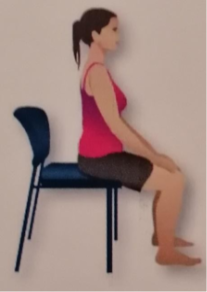 Pelvic floor exercise شرونیی منزل کی ورزش
Pelvic floor exercise شرونیی منزل کی ورزش
• Sit tall and evenly on a hard chair, (use a cushion if necessary), with your feet on the floor, hip distance apart.
• Breathe deeply expanding your rib cage and try and sit up a little taller.
• As you breathe out gently squeeze the muscles around your bottom (anus), and at the same time think of drawing up the muscles of the vagina or between the scrotum and anus. This is known as ‘engaging’ your pelvic floor. Try to keep the spine and pelvis still and shoulders relaxed.
TIP: These muscles can often be located by sucking your thumb! (Or when you try and stop yourself from passing urine.) Repeat x 5.
سخت کرسی پر لمبے اور یکساں طور پر بیٹھیں، (ایک کشن استعمال کریں
اگر ضروری ہو)، اپنے پیروں کو فرش پر، کولہے پر رکھیں
فاصلے کے علاوہ.
اپنے پسلی کے پنجرے کو پھیلاتے ہوئے گہرا سانس لیں اور کوشش کریں
اور تھوڑا سا اونچا بیٹھو.
جب آپ سانس باہر نکالیں تو آہستہ سے پٹھوں کو نچوڑیں
آپ کے نچلے حصے (مقعد) کے ارد گرد، اور اسی طرح
وقت کے پٹھوں کو ڈرائنگ کے بارے میں سوچتے ہیں
اندام نہانی یا سکروٹم اور مقعد کے درمیان۔ یہ
آپ کے شرونیی فرش کو 'مشغول' کے طور پر جانا جاتا ہے۔ کوشش کرو
ریڑھ کی ہڈی اور کمر کو ساکن اور کندھوں کو رکھیں
آرام دہ
ٹپ: یہ پٹھے اکثر چوسنے سے لگ سکتے ہیں•
آپ کا انگوٹھا! (یا جب آپ خود کو روکنے کی کوشش کرتے ہیں•
پیشاب کرنے سے۔) دہرائیں x 5۔
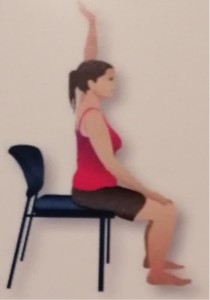 Arm raises بازو اٹھانا
Arm raises بازو اٹھانا
This exercise can help reduce tension in the neck and shoulders.
• Remain seated with your buttocks even on the chair, making sure your feet are firmly on the ground.
• Breathe in and sit a little taller.
• Breathe out, ‘engage’ your pelvic floor muscle and gently raise your right arm. Keep the elbow slightly soft and the shoulder blade set down your back.
• Breathe in and return the arm to your side.
TIP: Do not lean to the side as you raise your arm. Keep sitting tall. Repeat with each arm x 3.
یہ مشق گردن میں تناؤ کو کم کرنے میں مدد کر سکتی ہے•
کندھے
یہاں تک کہ اپنے کولہوں کے ساتھ بیٹھے رہیں
کرسی، اس بات کو یقینی بنانا کہ آپ کے پاؤں مضبوطی سے ہیں
زمین.
سانس لیں اور تھوڑا اونچا بیٹھیں•
سانس باہر نکالیں، اپنے شرونیی فرش کے پٹھوں کو 'مصروف' کریں•
اور آہستہ سے اپنے دائیں بازو کو اٹھائیں. کہنی رکھیں
قدرے نرم اور کندھے کا بلیڈ نیچے آ گیا•
آپ کی پیٹھ.
سانس لیں اور بازو کو اپنی طرف لوٹائیں•
مشورہ: بازو اٹھاتے وقت سائیڈ کی طرف نہ جھکیں•
اونچا بیٹھے رہیں۔ ہر بازو x 3 کے ساتھ دہرائیں•
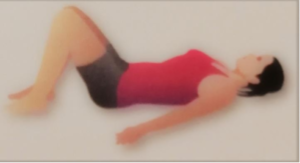 Pelvic tilts شرونیی جھکاؤ
Pelvic tilts شرونیی جھکاؤ
(use a thick mat on the floor or lie on the bed)
• Lie on your back, with your knees bent and feet on the floor. Try to keep the natural shape of your spine. You will probably have a small gap under your lumbar region, just enough to fit half a hand underneath.
• Breathe in and try to relax the upper body.
• Breathe out, gently engage the pelvic floor muscle, and then start to slowly curl your lower spine off the mat, one vertebra at a time, increasing the arch in your back.
• Breathe in at the end of this pelvic tilt.
• Breathe out, draw up the pelvic floor and flatten your spine down one vertebra at a time.
TIP: Do not attempt to come up too high. Keep hold of the pelvic floor muscle while moving.
(فرش پر موٹی چٹائی کا استعمال کریں یا لیٹ جائیں•
بستر)
اپنی پیٹھ پر، اپنے گھٹنوں کے ساتھ لیٹیں•
فرش پر جھکا اور پاؤں. کوشش کرو
اپنی قدرتی شکل کو برقرار رکھیں
پشتہ. آپ کے پاس شاید ایک ہوگا•
آپ کی ریڑھ کی ہڈی کے نیچے چھوٹا سا خلا
خطہ، نصف فٹ ہونے کے لیے کافی ہے•
ہاتھ نیچے.
سانس لیں اور آرام کرنے کی کوشش کریں•
اوپری جسم.
سانس باہر نکالیں، آہستہ سے مشغول کریں•
شرونیی منزل کے پٹھوں، اور پھر شروع
اپنی نچلی ریڑھ کی ہڈی کو آہستہ آہستہ کرل کرنے کے لیے
چٹائی، ایک وقت میں ایک ورٹیبرا،
اپنی پیٹھ میں محراب کو بڑھانا•
اس شرونی کے آخر میں سانس لیں•
جھکاؤ
سانس باہر نکالیں، شرونی کو اوپر کھینچیں•
فرش اور اپنی ریڑھ کی ہڈی کو چپٹا کریں•
ایک وقت میں ایک ورٹیبرا•
ٹپ: اوپر آنے کی کوشش بھی نہ کریں•
اعلی شرونیی فرش کو پکڑ کر رکھیں
حرکت کرتے وقت پٹھوں
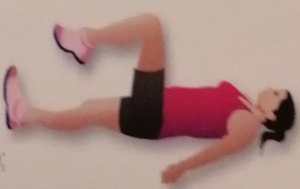 Leg lifting ٹانگ اٹھانا
Leg lifting ٹانگ اٹھانا
(use a thick mat on the floor or lie on the bed)
(DO NOT undertake this exercise for 8–12 weeks post surgery or until you feel comfortable).
• Lie flat on your back, keeping the natural shape of your spine and your pelvis very still.
• Breathe in, expanding your rib cage.
• As you breathe out, draw up the pelvic floor muscle, bring one knee up towards you so you have a right angle at your hip and knee.
• Breathe in, in this position. • Breathe out, draw up the pelvic floor and slowly return the foot to the floor.
TIP: Do not put pressure on the foot that remains on the floor. Keep your core muscles working and do not allow your pelvis to move from side to side. Repeat each leg x 3.
(فرش پر موٹی چٹائی کا استعمال کریں یا لیٹ جائیں•
بستر)
(کے لیے یہ مشق نہ کریں•
سرجری کے بعد 8-12 ہفتے یا آپ تک
آرام دہ محسوس کریں)۔ • اپنی پیٹھ پر چپٹا لیٹنا، رکھتے ہوئے
آپ کی ریڑھ کی ہڈی کی قدرتی شکل اور
آپ کا شرونی بہت ساکن ہے•
سانس لیں، اپنی توسیع کریں•
پسلی کا پنجرا
جیسے ہی آپ سانس باہر نکالیں، اوپر کھینچیں•
شرونیی منزل کا پٹھوں، ایک لاو
آپ کی طرف گھٹنے تو آپ کے پاس ہے
آپ کے کولہے اور گھٹنے پر صحیح زاویہ•
اس پوزیشن میں سانس لیں۔ • سانس باہر نکالیں، شرونی کو اوپر کھینچیں•
فرش اور آہستہ آہستہ واپس
فرش پر پاؤں.
ٹپ:
پر دباؤ نہ ڈالیں•
پاؤں جو فرش پر رہتا ہے•
اپنے بنیادی پٹھوں کو کام کرتے رہیں
اور اپنے شرونی کو اس کی اجازت نہ دیں•
ایک طرف سے دوسری طرف منتقل کریں. دہرائیں•
ہر ٹانگ x 3۔
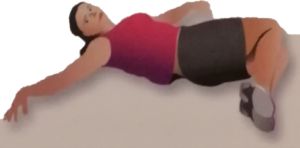 Knee rolls گھٹنے رول
Knee rolls گھٹنے رول
(use a thick mat on the floor or lie on the bed)
• Lie flat on your back with your arms out to the sides.
• Breathe in.
• Breathe out, draw up the pelvic floor and gently roll your knees a little way to one side. Do not allow the knees to drop to the floor.
• While still in this position, breathe in and hold briefly.
• Breathe out, draw up the pelvic floor and, using your abdominal muscles bring the knees back up.
TIP: Keep both shoulders blades on the floor. Repeat each side x 3.
فرش پر موٹی چٹائی کا استعمال کریں یا لیٹ جائیں•
بستر)
اپنے ساتھ اپنی پیٹھ کے بل لیٹ جائیں•
بازو اطراف کی طرف•
سانس اندر لیں•
سانس باہر نکالیں، شرونی کو اوپر کھینچیں•
فرش اور آہستہ سے اپنے گھٹنوں کو رول کریں a
ایک طرف تھوڑا سا راستہ. مت کرو
گھٹنوں کو نیچے گرنے دیں•
فرش
اس پوزیشن میں رہتے ہوئے، سانس لیں•
میں اور مختصر طور پر پکڑو.
سانس باہر نکالیں، شرونی کو اوپر کھینچیں•
فرش اور، آپ کے پیٹ کا استعمال کرتے ہوئے
عضلات گھٹنوں کو واپس اوپر لاتے ہیں•
مشورہ: دونوں کندھوں کے بلیڈ پر رکھیں
فرش ہر طرف x 3 کو دہرائیں•
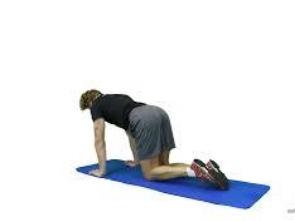
Kneeling گھٹنے ٹیکنا
(use a thick mat on the floor or lie on the bed)
• Kneel on all fours, making sure your knees are below your hips and your hands are under your shoulders. The elbows should not be locked and the back should be flat.
• Breathe in to the ribcage.
• Breathe out, draw up the pelvic floor, and try and lift your tummy towards your spine.
• Breathe in and release.
TIP: Try and keep your pelvis and spine still. Repeat x 3.
(فرش پر موٹی چٹائی کا استعمال کریں یا بستر پر لیٹ جائیں)
تمام چوکوں پر گھٹنے ٹیکیں، اس بات کو یقینی بنائیں کہ آپ کے گھٹنے نیچے ہیں•
آپ کے کولہے اور آپ کے ہاتھ آپ کے کندھوں کے نیچے ہیں۔ دی
کہنیوں کو بند نہیں کیا جانا چاہئے اور پیٹھ کو ہونا چاہئے•
فلیٹ ہو
پسلی کے پنجرے میں سانس لیں•
سانس باہر نکالیں، شرونیی فرش کو کھینچیں،
اور اپنے پیٹ کو اوپر اٹھانے کی کوشش کریں•
آپ کی ریڑھ کی ہڈی.
سانس لیں اور چھوڑ دیں•
مشورہ: کوشش کریں اور اپنے کمر اور ریڑھ کی ہڈی کو ساکن رکھیں۔ ایکس 3 کو دہرائیں•
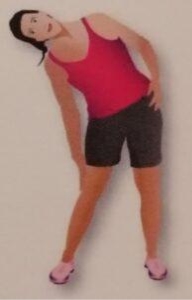 Standing side bend کھڑے سائیڈ موڑ
Standing side bend کھڑے سائیڈ موڑ
• Stand tall, keeping your arms by your side and your shoulders relaxed.
• Breathe in, and think of standing taller.
• Breathe out and draw up the pelvic floor. Gently lean to one side without pushing the hips out, sliding your hands down the outside thigh.
• Breathe in, and come back up to standing.
• Repeat to the other side.
TIP: Do not lean forward; imagine you are between two parallel walls. Repeat each side x 3.
اپنے بازوؤں کو اپنے اور اپنے پاس رکھتے ہوئے لمبے کھڑے رہیں
کندھے آرام دہ ہیں.
سانس لیں، اور لمبے کھڑے ہونے کے بارے میں سوچیں•
سانس لیں اور شرونیی فرش کو اوپر کھینچیں۔ آہستہ سے
کولہوں کو باہر دھکیلئے بغیر ایک طرف جھکنا،
اپنے ہاتھوں کو باہر کی ران سے نیچے پھسلانا•
سانس لیں، اور کھڑے ہونے کے لیے واپس آئیں•
دوسری طرف دہرائیں•
ٹِپ: آگے نہ جھکیں؛ تصور کریں کہ آپ دونوں کے درمیان ہیں•
متوازی دیواریں. ہر طرف x 3 کو دہرائیں•
 Relaxation
Relaxation
(use a thick mat on the floor or lie on the bed)
• Lie down on your back with your legs outstretched. Allow your toes to drop to the sides. Have your arms (palms up) just a little way away from your body and relax the body into the mat. Take your breathing deep into the tummy, and just allow some time for your muscles to relax. Calf raises
• Stand tall, keeping your shoulders relaxed and your arms down by your sides.
• Breathe in and push up on to your toes.
• Breathe out, engage your pelvic floor and slowly lower yourself down.
TIP: Try not to lean forward. Think of rising up in a straight line. Repeat x 5.
(فرش پر موٹی چٹائی کا استعمال کریں یا بستر پر لیٹ جائیں)
اپنی ٹانگیں پھیلا کر اپنی پیٹھ کے بل لیٹ جائیں۔ اپنی اجازت دیں•
انگلیوں کو اطراف میں چھوڑنا۔ اپنے بازو (ہتھیلیوں کو) تھوڑا سا رکھیں
اپنے جسم سے دور رہیں اور جسم کو چٹائی میں آرام کریں۔ لے لو
آپ کی سانسیں پیٹ میں گہری ہیں، اور بس کچھ وقت دیں•
آپ کے پٹھوں کو آرام کرنے کے لئے.
بچھڑا اٹھاتا
اپنے کندھوں کو آرام دہ اور پرسکون رکھتے ہوئے، لمبے کھڑے رہیں
آپ کے بازو آپ کی طرف سے نیچے.
سانس لیں اور اپنی انگلیوں کی طرف دھکیلیں•
سانس لیں، اپنے شرونیی فرش کو مشغول کریں اور آہستہ آہستہ
اپنے آپ کو نیچے کرو.
ٹپ: آگے نہ جھکنے کی کوشش کریں۔ ایک میں اٹھنے کا سوچو
سیدھی لکیر. ایکس 5 کو دہرائیں•
Walking
Walking is a great way to exercise as it can be as gentle or as brisk as you like. After surgery, walking will get your system moving and can help your recovery. Take things step–by–step to begin with; build up slowly, perhaps aiming to go a little further each day.
When you’re fully recovered, walking longer distances and walking more briskly is a great way to stay fit.
چہل قدمی ورزش کا ایک بہترین طریقہ ہے کیونکہ یہ آپ کی مرضی کے مطابق نرم یا تیز ہوسکتا ہے۔ کے بعد
سرجری، چہل قدمی آپ کے نظام کو متحرک کرے گی اور آپ کی صحت یابی میں مدد کر سکتی ہے•
چیزوں کو قدم بہ قدم شروع کرنے کے لیے آہستہ آہستہ تعمیر، شاید جانے کا مقصد a
ہر دن تھوڑا آگے.
جب آپ مکمل طور پر صحت یاب ہو جائیں، تو لمبی دوری پر چلنا اور زیادہ تیز چلنا ہے•
فٹ رہنے کا ایک بہترین طریقہ•

Running and jogging
If you were a runner prior to surgery, there’s no reason why you can’t continue after your operation. You will just need to build back up slowly. If you are new to running, you can follow a ‘beginners’ programme just like anyone else. Be aware though that you will need to work hard on your core stability – more so than someone who hasn’t gone through abdominal surgery - to stay injury free, so ask a physiotherapist or qualified running coach for advice.
اگر آپ سرجری سے پہلے رنر تھے، تو کوئی وجہ نہیں ہے کہ آپ اس کے بعد کیوں جاری نہیں رہ سکتے
آپ کا آپریشن. آپ کو بس آہستہ آہستہ بیک اپ بنانے کی ضرورت ہوگی۔ اگر آپ دوڑنے میں نئے ہیں،
آپ کسی اور کی طرح 'ابتدائی' پروگرام کی پیروی کر سکتے ہیں•
اس بات سے آگاہ رہیں کہ آپ کو اپنے بنیادی استحکام پر سخت محنت کرنے کی ضرورت ہوگی•
کسی ایسے شخص کے مقابلے جس نے پیٹ کی سرجری نہیں کی ہے - چوٹ سے پاک رہنے کے لیے، لہذا
مشورہ کے لیے فزیو تھراپسٹ یا کوالیفائیڈ رننگ کوچ سے پوچھیں•

Yoga and pilates
Your posture, strength and flexibility will all have been affected by surgery, periods of bed rest and recovery. A Pilates or yoga class is an ideal way to relax and rebuild confidence in your body while at the same time helping you to be more active. You may need to adopt positions where you lie on your stomach, so make sure to ask your instructor for advice and always listen to your body.
آپ کی کرنسی، طاقت اور لچک سبھی سرجری، ادوار سے متاثر ہوں گی•
بستر پر آرام اور بحالی کا۔ پیلیٹس یا یوگا کلاس آرام کرنے اور دوبارہ تعمیر کرنے کا ایک مثالی طریقہ ہے•
آپ کے جسم پر اعتماد جبکہ ایک ہی وقت میں آپ کو زیادہ متحرک رہنے میں مدد فراہم کرتا ہے۔ تم
جہاں آپ اپنے پیٹ کے بل لیٹتے ہیں اس کو اپنانے کی ضرورت پڑ سکتی ہے، اس لیے پوچھنا یقینی بنائیں
مشورہ کے لیے آپ کا انسٹرکٹر اور ہمیشہ اپنے جسم کو سنیں•
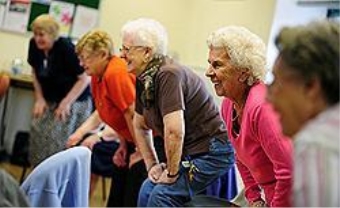
Cycling
Riding a bike can be an excellent form of exercise for ostomates, as it does not put too much strain on your abdomen or involve heavy impact. Just like walking, cycling should be introduced gradually and then increased over time to higher levels of activity.
If you have a perineal wound, cycling is best avoided until the wound has healed, as sitting on the saddle may be uncomfortable.
سائیکل پر سوار ہونا اوسٹومیٹس کے لیے ورزش کی ایک بہترین شکل ہو سکتی ہے، جیسا کہ ایسا نہیں ہے•
اپنے پیٹ پر بہت زیادہ دباؤ ڈالیں یا بھاری اثر ڈالیں۔ بس چلنے کی طرح،
سائیکلنگ کو بتدریج متعارف کرایا جانا چاہئے اور پھر اسے وقت کے ساتھ ساتھ بڑھانا چاہئے•
سرگرمی کی سطح.
اگر آپ کو پیرینیل زخم ہے تو، زخم کے ٹھیک ہونے تک سائیکل چلانے سے گریز کیا جاتا ہے،
کیونکہ زین پر بیٹھنا تکلیف دہ ہو سکتا ہے•

Swimming
Swimming is a fantastic activity for people with a stoma as it promotes cardiovascular fitness and toning. It is natural to have concerns about swimming; some ostomates worry about their bag leaking or feel self conscious in pools or at the beach. However, the adhesive on stoma bags remains effective in water.
Flange extenders can give you further security too. Likewise, there is a wide range of swimwear available that provides support and discretion. You can find further information about suppliers in our clothing factsheet. You can download this free from our website, or call us and we will send you a copy.
Although ostomates may worry that others in the pool will turn and stare at their bag, the truth is, most people won’t even notice the colour of your swimming costume, let alone what may lie beneath it!
سٹوما والے لوگوں کے لیے تیراکی ایک لاجواب سرگرمی ہے کیونکہ یہ فروغ دیتی ہے•
قلبی تندرستی اور ٹننگ۔ تیراکی کے بارے میں خدشات کا ہونا فطری بات ہے•
کچھ اوسٹومیٹ اپنے بیگ کے لیک ہونے کی فکر کرتے ہیں یا تالابوں میں خود کو ہوش میں محسوس کرتے ہیں یا
ساحل پر. تاہم، سٹوما بیگ پر چپکنے والا پانی میں موثر رہتا ہے•
فلینج ایکسٹینڈر آپ کو مزید سیکیورٹی بھی دے سکتے ہیں۔ اسی طرح، ایک وسیع رینج ہے
دستیاب تیراکی کے لباس جو مدد اور صوابدید فراہم کرتے ہیں۔ آپ مزید تلاش کر سکتے ہیں•
ہماری کپڑوں کی فیکٹ شیٹ میں فراہم کنندگان کے بارے میں معلومات۔ آپ اسے مفت ڈاؤن لوڈ کر سکتے ہیں•
ہماری ویب سائٹ سے، یا ہمیں کال کریں اور ہم آپ کو ایک کاپی بھیجیں گے•
اگرچہ آسٹومیٹس کو اس بات کی فکر ہو سکتی ہے کہ پول میں موجود دوسرے لوگ مڑ کر ان کی طرف گھوریں گے•
بیگ، سچ تو یہ ہے کہ زیادہ تر لوگ آپ کے تیراکی کے رنگ کو بھی نہیں دیکھیں گے•
لباس، اس کے نیچے کیا پڑ سکتا ہے چھوڑ دو!

Fitness classes and the gym
Once you are fully recovered from surgery, you can start to use light weights in the gym and participate in fitness classes such as Zumba and aerobics. Start very gently and if you experience any discomfort or pain in your scar or around your stoma stop immediately. It can be helpful to have a programme put together for you by a trainer or physiotherapist. They can also show you how to execute the exercises properly. Most gyms and leisure centres offer this type of service.
سرجری سے مکمل طور پر صحت یاب ہونے کے بعد، آپ ہلکے وزن کا استعمال شروع کر سکتے ہیں•
جم اور فٹنس کلاسز جیسے زومبا اور ایروبکس میں شرکت کریں۔ بہت شروع کریں•
آہستہ سے اور اگر آپ کو اپنے داغ میں یا اپنے آس پاس کوئی تکلیف یا درد محسوس ہوتا ہے•
سٹوما فوری طور پر بند کرو. اس کے لیے ایک پروگرام رکھنا مددگار ثابت ہو سکتا ہے•
آپ کو کسی ٹرینر یا فزیو تھراپسٹ کے ذریعے۔ وہ آپ کو یہ بھی دکھا سکتے ہیں کہ کس طرح عمل کرنا ہے•
مناسب طریقے سے مشقیں. زیادہ تر جم اور تفریحی مراکز اس قسم کی خدمت پیش کرتے ہیں•
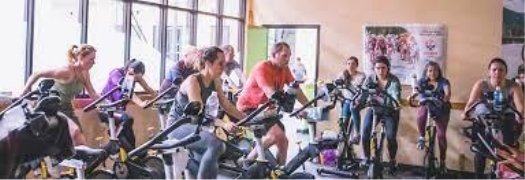
Managing your stoma اپنے اسٹوما کا انتظام
While being active You may find it helpful to adjust meal times so that your stoma is less likely to be active during exercise. Alternatively you could change the time you are going to undertake an activity. Exercising with a full bag can be uncomfortable and it is also more likely to leak. It is through trial and error and listening to your body, that you will determine the right times to eat and exercise.
Other tips when undertaking exercise:
• Take some spare supplies with you in case of an emergency.
• If you are finding it difficult to get motivated to exercise, then try and focus on all the positives of physical activity. Ask your friends and family to encourage you or, better still, find someone that is willing to partner you and get fit too.
• It is important to stay well fuelled and hydrated during physical activity. High energy foods such as bananas and protein bars are easy to digest and have the added benefit of being easy to carry with you.
فعال ہونے کے دوران
آپ کو کھانے کے اوقات کو ایڈجسٹ کرنے میں مدد مل سکتی ہے تاکہ آپ کے سٹوما کا امکان کم ہو•
ورزش کے دوران فعال. متبادل طور پر آپ جس وقت جا رہے ہیں اسے تبدیل کر سکتے ہیں•
ایک سرگرمی شروع کریں. پورے بیگ کے ساتھ ورزش کرنا تکلیف دہ ہوسکتا ہے اور یہ بھی ہے•
لیک ہونے کا امکان زیادہ ہے۔ یہ آزمائش اور غلطی اور آپ کے جسم کو سننے کے ذریعے ہے، کہ آپ
کھانے اور ورزش کے صحیح اوقات کا تعین کرے گا•
ورزش کرتے وقت دیگر تجاویز:
ہنگامی صورت حال کی صورت میں کچھ اضافی سامان اپنے ساتھ لے جائیں•
اگر آپ کو ورزش کے لیے حوصلہ افزائی کرنا مشکل ہو رہا ہے، تو کوشش کریں•
جسمانی سرگرمی کے تمام مثبت پہلوؤں پر توجہ دیں۔ اپنے دوستوں اور خاندان والوں سے پوچھیں•
آپ کی حوصلہ افزائی کریں یا پھر بھی بہتر، کسی ایسے شخص کو تلاش کریں جو آپ کے ساتھ شراکت کرنے کے لیے تیار ہو•
بھی فٹ ہو جاؤ.
جسمانی سرگرمی کے دوران اچھی طرح سے ایندھن اور ہائیڈریٹ رہنا ضروری ہے•
اعلی توانائی والے کھانے جیسے کیلے اور پروٹین کی سلاخیں ہضم کرنے میں آسان ہیں اور
اپنے ساتھ لے جانے میں آسان ہونے کا اضافی فائدہ ہے•
Hernia prevention ہرنیا کی روک تھام
When a stoma is formed, a potential site of weakness is created in the abdominal muscles. This can lead to a bulge developing under the skin around the stoma, where the contents of the abdomen push through the muscle layer. This is known as a parastomal hernia. It is thought that as many as 50% of ostomates have one.
This is one of the key reasons why heavy lifting should be avoided after surgery (first three months) and then built up gradually afterwards, maintaining good posture all the time in order to encourage your muscles to develop correctly.
The development of a parastomal hernia is linked with being overweight and having poor abdominal muscles. Studies show that appropriate diet and abdominal exercises and the use of support belts and garments when engaged in physical activity significantly reduce the risk of developing a hernia. Details of these can be obtained from your stoma care nurse or via our website. We also produce a booklet about Parastomal Hernias, just call us for a copy or download one from our website.
NB: If you have a hernia, then you should speak to your doctor before undertaking any new exercise programme.
جب سٹوما بنتا ہے تو پیٹ میں کمزوری کی ممکنہ جگہ بن جاتی ہے•
پٹھوں. یہ سٹوما کے ارد گرد جلد کے نیچے ایک بلج کی ترقی کا باعث بن سکتا ہے،
جہاں پیٹ کے مواد پٹھوں کی تہہ کے ذریعے دھکیلتے ہیں۔ یہ معلوم ہے•
ایک parastomal ہرنیا کے طور پر. یہ خیال کیا جاتا ہے کہ زیادہ سے زیادہ 50٪ آسٹومیٹ میں ایک ہوتا ہے•
یہ ان اہم وجوہات میں سے ایک ہے جس کی وجہ سے سرجری کے بعد بھاری وزن اٹھانے سے گریز کیا جانا چاہیے•
(پہلے تین ماہ) اور پھر اس کے بعد آہستہ آہستہ تعمیر کیا، اچھی طرح سے برقرار رکھا
آپ کے پٹھوں کو صحیح طریقے سے نشوونما کرنے کی ترغیب دینے کے لئے ہر وقت کرنسی رکھیں•
پیراسٹومل ہرنیا کی نشوونما کا تعلق زیادہ وزن سے ہے•
اور پیٹ کے کمزور پٹھوں کا ہونا۔ مطالعات سے پتہ چلتا ہے کہ مناسب خوراک اور
پیٹ کی مشقیں اور مشغول ہونے پر سپورٹ بیلٹ اور کپڑوں کا استعمال
جسمانی سرگرمی میں نمایاں طور پر ایک ہرنیا کی ترقی کے خطرے کو کم. کی تفصیلات
یہ آپ کی سٹوما کیئر نرس سے یا ہماری ویب سائٹ کے ذریعے حاصل کی جا سکتی ہیں۔ ہم بھی
Parastomal Hernias کے بارے میں ایک کتابچہ تیار کریں، صرف ایک کاپی یا ڈاؤن لوڈ کے لیے ہمیں کال کریں•
ہماری ویب سائٹ سے ایک•
نوٹ: اگر آپ کو ہرنیا ہے، تو آپ کو پہلے اپنے ڈاکٹر سے بات کرنی چاہیے•
ورزش کا کوئی نیا پروگرام شروع کرنا•
Getting a good night’s sleep
Sleep is extremely important to your health and wellbeing, but some people who have stomas feel anxious about sleeping, or find that problems with their stoma (such as leaks) disrupt their slumber.
While you are asleep, your body is busy restoring and repairing, which promotes better physical and mental performance and improves mood. Not getting enough sleep can affect your concentration, how you feel and your energy levels.
Everyone has a night-time routine, but those with a stoma may benefit from adding a few extra steps before settling down to ensure a good night’s sleep.
نیند آپ کی صحت اور تندرستی کے لیے انتہائی اہم ہے، لیکن کچھ لوگ جن کو سٹوما ہوتا ہے وہ نیند کے بارے میں بے چینی محسوس کرتے ہیں، یا ان کے سٹوما کے مسائل (جیسے لیک ہونے) سے ان کی نیند میں خلل پڑتا ہے
جب آپ سو رہے ہوتے ہیں، آپ کا جسم بحالی اور مرمت میں مصروف ہوتا ہے، جو بہتر جسمانی اور ذہنی کارکردگی کو فروغ دیتا ہے اور موڈ کو بہتر بناتا ہے۔ کافی نیند نہ لینا آپ کے ارتکاز، آپ کیسا محسوس کرتا ہے اور آپ کی توانائی کی سطح کو متاثر کر سکتا ہے
ہر ایک کا رات کے وقت کا معمول ہوتا ہے، لیکن جن لوگوں کو سٹوما ہوتا ہے وہ اچھی رات کی نیند کو یقینی بنانے کے لیے بسنے سے پہلے کچھ اضافی اقدامات کرنے سے فائدہ اٹھا سکتے ہیں
Change or empty your bag before bed
Always change or empty your bag before going to sleep. If your bag overfills at night you are at risk of a leak. Going to bed with an empty bag can reduce anxiety about leaks and significantly improve the quality of your sleep.
سونے سے پہلے ہمیشہ اپنا بیگ تبدیل کریں یا خالی کریں۔ اگر آپ کا بیگ رات کو زیادہ بھر جاتا ہے تو آپ کو لیک ہونے کا خطرہ ہوتا ہے۔ خالی بیگ کے ساتھ بستر پر جانا لیک کے بارے میں تشویش کو کم کر سکتا ہے اور آپ کی نیند کے معیار کو نمایاں طور پر بہتر بنا سکتا ہے
Make sure your bag is secure
It sounds obvious, but check and double check that your bag is secure before you go to sleep. When you put the bag on, make sure your skin is completely dry. Avoid using creams on the skin that could interfere with adhesion. Ensure the hole for your stoma is the right size and fits snugly around your stoma. If the hole is too large, it can cause leaks, affect adhesion, and harm the skin. If you have dips and creases that are causing leaks, there are products that you can use to level out uneven skin surfaces and ensure a good seal. Flange extenders may also help – especially if you have a hernia. Speak to your stoma care nurse for advice on ensuring that your bag is secure.
یہ واضح لگتا ہے، لیکن سونے سے پہلے چیک کریں اور دو بار چیک کریں کہ آپ کا بیگ محفوظ ہے۔ جب آپ بیگ ڈالتے ہیں، تو یقینی بنائیں کہ آپ کی جلد مکمل طور پر خشک ہے۔ جلد پر ایسی کریموں کے استعمال سے گریز کریں جو چپکنے میں مداخلت کر سکتی ہیں۔ یقینی بنائیں کہ آپ کے سٹوما کا سوراخ صحیح سائز کا ہے اور آپ کے سٹوما کے ارد گرد اچھی طرح سے فٹ بیٹھتا ہے۔ اگر سوراخ بہت بڑا ہے، تو یہ رساو کا سبب بن سکتا ہے، چپکنے کو متاثر کر سکتا ہے، اور جلد کو نقصان پہنچا سکتا ہے۔ اگر آپ کے پاس ڈِپس اور کریزز ہیں جو لیک ہونے کا سبب بن رہے ہیں، تو ایسی پروڈکٹس ہیں جنہیں آپ جلد کی ناہموار سطحوں کو برابر کرنے اور اچھی مہر کو یقینی بنانے کے لیے استعمال کر سکتے ہیں۔ فلینج ایکسٹینڈر بھی مدد کر سکتے ہیں – خاص طور پر اگر آپ کو ہرنیا ہے۔ اس بات کو یقینی بنانے کے لیے کہ آپ کا بیگ محفوظ ہے، مشورہ کے لیے اپنی اسٹوما کیئر نرس سے بات کریں
Use the right bag
If you have a high output stoma, then a high output bag which has increased capacity, will reduce the number of times you need to get up in the night to empty your bag. Your stoma care nurse will be able to advise you on bags, and you can also order samples from different suppliers until you find the best night-time bag for you.
آپ کے پاس زیادہ آؤٹ پٹ سٹوما ہے، پھر ایک اعلی آؤٹ پٹ بیگ جس کی گنجائش بڑھ گئی ہے، آپ کو اپنے بیگ کو خالی کرنے کے لیے رات کو اٹھنے کی ضرورت کی تعداد کو کم کر دے گا۔ آپ کی سٹوما کی دیکھ بھال کرنے والی نرس آپ کو تھیلوں کے بارے میں مشورہ دے سکے گی، اور آپ مختلف سپلائرز سے نمونے بھی منگو سکتے ہیں جب تک کہ آپ کو رات کا بہترین بیگ نہ مل جائے
Plan your meal times
If you have a large meal before bed, this could increase your output overnight and disrupt your sleep. You could choose to have your main meal at lunch time and a smaller evening meal a few hours before bed or have your dinner earlier. Experiment and find out what works best for you.
Avoiding foods that produce wind can help to prevent ballooning (where your bag fills with gas)
گر آپ سونے سے پہلے زیادہ کھانا کھاتے ہیں، تو یہ رات بھر آپ کی پیداوار کو بڑھا سکتا ہے اور آپ کی نیند میں خلل ڈال سکتا ہے۔ آپ اپنا بنیادی کھانا دوپہر کے کھانے کے وقت اور ایک چھوٹا شام کا کھانا سونے سے چند گھنٹے پہلے یا رات کا کھانا پہلے کھانے کا انتخاب کر سکتے ہیں۔ تجربہ کریں اور معلوم کریں کہ آپ کے لیے کیا بہترین کام کرتا ہے
ہوا پیدا کرنے والی کھانوں سے پرہیز کرنے سے غبارے کو روکنے میں مدد مل سکتی ہے (جہاں آپ کا بیگ گیس سے بھر جاتا ہے) –
Reducing output
If your stoma is still very active, you could speak to your stoma care nurse about over the counter treatments which could slow your output down over night. If your output is very liquid, you could consider output thickeners.
گر آپ کا سٹوما اب بھی بہت فعال ہے، تو آپ کاؤنٹر پر علاج کے بارے میں اپنی سٹوما کیئر نرس سے بات کر سکتے ہیں جو رات بھر آپ کے آؤٹ پٹ کو کم کر سکتا ہے۔ اگر آپ کا آؤٹ پٹ بہت مائع ہے، تو آپ آؤٹ پٹ گاڑھا کرنے والوں پر غور کر سکتے ہیں
Find a sleeping position that works for you
The best position to sleep in when you have a stoma is on your back, or on your side. If you prefer to sleep on your stomach, this will be fine at the beginning of the night but increases the chances of leaks as the night progresses and your bag fills. To overcome this, you can modify your sleeping position by bending the leg on the side with your stoma. This creates some space underneath your abdomen that allows the bag to fill.
Sleeping on either side of your body is fine. On the side with your stoma, your mattress will support the bag as it fills. If you sleep on the other side, you can lay next to a pillow to support the weight of your bag.
جب آپ کو سٹوما ہو تو سونے کے لیے بہترین پوزیشن آپ کی پیٹھ پر، یا آپ کی طرف ہے۔ اگر آپ پیٹ کے بل سونے کو ترجیح دیتے ہیں تو یہ رات کے شروع میں ٹھیک رہے گا لیکن رات کے بڑھنے اور آپ کا بیگ بھرنے کے ساتھ لیک ہونے کے امکانات بڑھ جاتے ہیں۔ اس پر قابو پانے کے لیے، آپ اپنے سٹوما کے ساتھ ٹانگ کو سائیڈ پر موڑ کر اپنی نیند کی پوزیشن میں ترمیم کر سکتے ہیں۔ یہ آپ کے پیٹ کے نیچے کچھ جگہ بناتا ہے جو بیگ کو بھرنے دیتا ہے
آپ کے جسم کے دونوں طرف سونا ٹھیک ہے۔ آپ کے سٹوما کے ساتھ، آپ کا توشک بیگ کو بھرتے ہی سہارا دے گا۔ اگر آپ دوسری طرف سوتے ہیں، تو آپ اپنے بیگ کے وزن کو سہارا دینے کے لیے تکیے کے پاس لیٹ سکتے ہیں
ت کو خالی کرنے سے پہلے اپنے بیگ کو زیادہ بھرنے نہ دینے کی کوشش کریں۔ آپ کی سرجری کے بعد ابتدائی دنوں میں، آپ کو اٹھنے اور اپنا بیگ خالی کرنے کے لیے رات کے وقت ایک یا دو بجے الارم لگانے میں مدد مل سکتی ہے
قبول کریں کہ لیکس ہوں گے اور تیار رہیں
پاجامے، سٹوما کے سامان اور فالتو بیڈ شیٹس کی تبدیلی ہاتھ پر رکھیں۔ اس سے آدھی رات میں رساو سے نمٹنا آسان ہو جائے گا
بے ضابطگی کی چادر، پپی پیڈ یا گہرے تولیے کے اوپر سو جائیں۔ (کچھ لوگ کتے کے تربیتی پیڈ کو جوڑتے ہیں
If you are worried that you will not stay on your side during the night, use a pillow/body pillow/V-shaped pillow to keep your body in place.
Take steps to reduce the chance of leaks
Try not to allow your bag to get too full in the night before emptying. In the early days after your surgery, it may help to set an alarm or two during the night to prompt you to get up and empty your bag. Accept that leaks will happen and be prepared
• Keep a change of pyjamas, stoma supplies and spare bed sheets on hand. This will make it easier to deal with a leak in the middle of the night.
• Sleep on top of an incontinence sheet, puppy pad or dark towel. (Some people fold a puppy training pad and tuck it between their pants, ensuring that it covers the stoma bag – if you do have a leak, it then goes onto the pad, rather than your clothes.)
• Use a waterproof mattress cover.
• Dark fitted sheets and patterned duvet covers can help to disguise stains caused by bag leaks so that you don’t have to throw your bedding away.
را اور اسے اپنی پتلون کے درمیان ٹکاتے ہیں، اس بات کو یقینی بناتے ہوئے کہ یہ سٹوما بیگ کو ڈھانپ لے – اگر آپ کو رساو ہے، تو یہ آپ کے کپڑوں کی بجائے پیڈ پر چلا جاتا ہے۔)
واٹر پروف توشک کا احاطہ استعمال کریں
گہرے رنگ کی چادریں اور پیٹرن والے ڈیویٹ کور بیگ لیک ہونے کی وجہ سے داغوں کو چھپانے میں مدد کر سکتے ہیں تاکہ آپ کو اپنا بستر پھینکنے کی ضرورت نہ پڑے
Good sleep hygiene
You may find that you are struggling to sleep and it has nothing to do with your stoma management. Good sleep hygiene can help:
• Sleep at regular times – routine helps to get a good night’s sleep.
• Make sure you wind down properly before bed. This could be achieved with a warm (not hot) bath, or by writing “to do” lists for the next day. This can organize your thoughts and clear your mind of any distractions. Avoid using smartphones, tablets or other electronic devices for an hour or so before you go to bed as the light from the screen on these devices can have a negative effect on sleep.
• Make your bedroom sleep friendly. This means creating a relaxing environment. Your bedroom ideally needs to be dark, quiet, tidy and be kept at a temperature of between 18C and 24C.
آپ کو معلوم ہو سکتا ہے کہ آپ کو نیند آنے میں دشواری ہو رہی ہے اور اس کا آپ کے سٹوما کے انتظام سے کوئی تعلق نہیں ہے۔ اچھی نیند کی حفظان صحت مدد کر سکتی ہے:
باقاعدہ وقت پر سوئیں - معمول رات کو اچھی نیند لینے میں مدد کرتا ہے•
اس بات کو یقینی بنائیں کہ آپ سونے سے پہلے مناسب طریقے سے نیچے سمیٹ لیں۔ یہ گرم (گرم نہیں) غسل کے ساتھ، یا اگلے دن کے لیے "کرنے کے لیے" کی فہرستیں لکھ کر حاصل کیا جا سکتا ہے۔ یہ آپ کے خیالات کو منظم کر سکتا ہے اور آپ کے ذہن کو کسی بھی خلفشار سے پاک کر سکتا ہے۔ سونے سے ایک گھنٹہ پہلے اسمارٹ فونز، ٹیبلیٹ یا دیگر الیکٹرانک ڈیوائسز استعمال کرنے سے گریز کریں کیونکہ ان ڈیوائسز کی اسکرین سے آنے والی روشنی نیند پر منفی اثر ڈال سکتی ہے•
اپنے سونے کے کمرے کی نیند کو دوستانہ بنائیں۔ اس کا مطلب ہے آرام دہ ماحول پیدا کرنا۔ آپ کے بیڈروم کو مثالی طور پر تاریک، پرسکون، صاف ستھرا اور 18C اور 24C کے درمیان درجہ حرارت پر رکھنے کی ضرورت ہے•
Tackling the ‘firsts’ after stoma surgery
Many new ostomates worry about the ‘firsts’ after stoma surgery, whether that’s the first meal out, the first time going to the shops, or the first time using a public toilet. The first time doing something when you’re living with a stoma can be daunting, and even more so if it has been delayed by lockdown or shielding.
We are here to guide you through these firsts, and help you enjoy being out and about. In order to compile these tips, we reached out to our wonderful helpline volunteers, and they have provided some brilliant advice to help you to feel confident. The overarching message from our volunteers was ‘be prepared, and remember no one will know that you have a stoma – unless you tell them’. One volunteer described her first outing after stoma surgery and said “I was quite shocked to find no body looked at my tummy even those who knew I had the operation… if you draw attention to your tummy by walking ‘funny’ or keeping your hand over your stoma of course people will wonder what’s up. No one notices your tummy if you carry on as normal.”
We recommend staying local to begin with and making sure you have a good idea of where the toilets are nearby.
بہت سے نئے آسٹومیٹس سٹوما سرجری کے بعد 'پہلے' کے بارے میں فکر مند ہیں، چاہے وہ پہلا کھانا ہو، پہلی بار دکانوں پر جانا ہو، یا پہلی بار عوامی بیت الخلا استعمال کرنا ہو۔ جب آپ اسٹوما کے ساتھ رہ رہے ہوں تو پہلی بار کچھ کرنا مشکل ہوسکتا ہے، اور اس سے بھی زیادہ اگر اس میں لاک ڈاؤن یا شیلڈنگ کی وجہ سے تاخیر ہوئی ہو
ہم یہاں ان سب سے پہلے آپ کی رہنمائی کرنے کے لیے ہیں، اور آپ کو باہر رہنے سے لطف اندوز ہونے میں مدد کرتے ہیں۔ ان تجاویز کو مرتب کرنے کے لیے، ہم نے اپنے شاندار ہیلپ لائن رضاکاروں سے رابطہ کیا، اور انھوں نے آپ کو اعتماد محسوس کرنے میں مدد کرنے کے لیے کچھ شاندار مشورے فراہم کیے ہیں۔ ہمارے رضاکاروں کا سب سے اہم پیغام تھا 'تیار رہو، اور یاد رکھیں کہ کوئی بھی نہیں جان سکے گا کہ آپ کو سٹوما ہے - جب تک کہ آپ انہیں نہ بتائیں'۔ ایک رضاکار نے سٹوما کی سرجری کے بعد اپنے پہلے باہر نکلنے کے بارے میں بتایا اور کہا کہ "مجھے یہ دیکھ کر کافی صدمہ ہوا کہ میرے پیٹ کی طرف کسی جسم کو نہیں دیکھا حتیٰ کہ وہ لوگ جو جانتے تھے کہ میرا آپریشن ہوا ہے... آپ کا سٹوما یقیناً لوگ حیران ہوں گے کہ کیا ہو رہا ہے۔ اگر آپ معمول کے مطابق چلتے رہیں تو کوئی بھی آپ کے پیٹ کو نہیں دیکھتا
ہم شروع کرنے کے لیے مقامی رہنے کی تجویز کرتے ہیں اور اس بات کو یقینی بناتے ہیں کہ آپ کو اس بات کا بخوبی اندازہ ہے کہ بیت الخلا قریب میں کہاں ہیں
Managing output
If your stoma is very active, you could speak to your stoma care nurse about over the counter treatments which could slow your output down while you’re out and about. If your output is very liquid, you could consider output thickeners. If you are worried about leaks, check out our advice on managing and preventing leaks.
اگر آپ کا سٹوما بہت فعال ہے، تو آپ کاؤنٹر کے علاج کے بارے میں اپنی سٹوما کیئر نرس سے بات کر سکتے ہیں جو آپ کے باہر جانے کے دوران آپ کے آؤٹ پٹ کو سست کر سکتا ہے۔ اگر آپ کا آؤٹ پٹ بہت مائع ہے، تو آپ آؤٹ پٹ گاڑھا کرنے والوں پر غور کر سکتے ہیں۔ اگر آپ لیک کے بارے میں فکر مند ہیں تو، لیک کے انتظام اور روک تھام کے بارے میں ہمارے مشورے کو دیکھیں
Going out
Our volunteers had plenty of tips to help you to feel confident when leaving the house. First things first, always make sure bag is secure and empty before going out. All of our volunteers said that they ensure that they have supplies with them as it’s ‘better to be safe than sorry’. This includes all your stoma supplies (such as a few bags, a small pack of wet/dry wipes, adhesive removal spray, disposal bags etc) as well as spare clothing and a towel.
ہمارے رضاکاروں کے پاس گھر سے نکلتے وقت آپ کو اعتماد محسوس کرنے میں مدد کرنے کے لیے کافی تجاویز تھیں۔ سب سے پہلے سب سے پہلے، ہمیشہ یقینی بنائیں کہ بیگ محفوظ اور خالی ہے باہر جانے سے پہلے۔ ہمارے تمام رضاکاروں نے کہا کہ وہ اس بات کو یقینی بناتے ہیں کہ ان کے پاس سامان موجود ہے کیونکہ 'افسوس سے محفوظ رہنا بہتر ہے'۔ اس میں آپ کے سٹوما کے تمام سامان (جیسے چند بیگ، گیلے/خشک مسحوں کا ایک چھوٹا سا پیکٹ، چپکنے والا اسپرے، ڈسپوزل بیگ وغیرہ) کے ساتھ ساتھ اضافی کپڑے اور ایک تولیہ شامل ہے
Stoma problems
Most people are able to live life with a stoma as they did before their surgery. But sometimes stoma problems arise which cause concern.
Some of the most common problems are:
- Ballooning غبارہ
Ballooning occurs when gas expelled through the colon collects inside the bag causing it to inflate. Most bags have a filter which allows this gas to escape. Occasionally the filter will block and the bag needs to be changed. If this happens to you regularly, it may be worth trying a different bag. When in the bath, shower, or swimming ensure the filter does not get wet and become ineffective; you can cover it with a sticky patch supplied in your box of stoma bags.
غبارہ اس وقت ہوتا ہے جب بڑی آنت کے ذریعے خارج ہونے والی گیس بیگ کے اندر جمع ہو جاتی ہے جس کی وجہ سے یہ پھول جاتا ہے۔ زیادہ تر تھیلوں میں فلٹر ہوتا ہے جو اس گیس کو نکلنے دیتا ہے۔ کبھی کبھار فلٹر بلاک ہوجاتا ہے اور بیگ کو تبدیل کرنے کی ضرورت ہوتی ہے۔ اگر یہ آپ کے ساتھ باقاعدگی سے ہوتا ہے، تو یہ ایک مختلف بیگ آزمانے کے قابل ہو سکتا ہے۔ جب نہانے، شاور، یا تیراکی میں ہو تو یقینی بنائیں کہ فلٹر گیلا نہ ہو اور ناکارہ ہو جائے۔ آپ اسے اپنے سٹوما بیگ کے باکس میں فراہم کردہ چپچپا پیچ سے ڈھانپ سکتے ہیں•
- Blockages رکاوٹیں
A blockage, also known as a bowel obstruction, leads to the output from your stoma slowing down or even stopping completely. The latter can happen suddenly. Blockages can occur either in the small or large bowel. A blockage can be described as partial or complete.
In a partial bowel obstruction, a small amount of liquid output manages to bypass the obstruction in the bowel, resulting in a liquid/mucous type of bowel motion from your stoma. In a partial bowel obstruction, you may still experience windy output from your stoma. In a complete bowel obstruction, the bowel is unable to release any output at all from the stoma.
ایک رکاوٹ، جسے آنتوں میں رکاوٹ بھی کہا جاتا ہے، آپ کے سٹوما کی پیداوار کو سست یا مکمل طور پر رکنے کا باعث بنتا ہے۔ مؤخر الذکر اچانک ہوسکتا ہے۔ رکاوٹیں چھوٹی یا بڑی آنتوں میں ہوسکتی ہیں۔ رکاوٹ کو جزوی یا مکمل قرار دیا جا سکتا ہے•
جزوی آنتوں کی رکاوٹ میں، مائع کی پیداوار کی ایک چھوٹی سی مقدار آنتوں میں رکاوٹ کو نظرانداز کرنے کا انتظام کرتی ہے، جس کے نتیجے میں آپ کے سٹوما سے ایک مائع/بلغم قسم کی آنتوں کی حرکت ہوتی ہے۔ آنتوں کی جزوی رکاوٹ میں، آپ کو اب بھی اپنے سٹوما سے ہوا نکلنے کا تجربہ ہو سکتا ہے۔ آنتوں کی مکمل رکاوٹ میں، آنت سٹوما سے بالکل بھی کوئی پیداوار جاری کرنے سے قاصر ہے•
Causes of blocked stoma/bowel obstruction بلاک شدہ سٹوما / آنتوں کی رکاوٹ کی وجوہات
It is not uncommon for people with a stoma to, at some point, experience a bowel obstruction. There are many different reasons why the small bowel may become obstructed. If you experience bowel obstruction, and you have been previously diagnosed with any of the following, you should seek medical attention by contacting your GP, Stoma Nurse
• diverticulitis;
• inflammatory bowel disease, which may cause strictures or narrowing in the bowel which can cause obstructions;
• volvulus, otherwise, knows as twisted bowel;
• abdominal or parastomal hernia, which may cause strangulation of the bowel;
• adhesions or strictures in the bowel following colorectal surgery;
• recent abdominal or pelvic surgery; or
• bowel cancer.
But poorly digested food is the main reason for people with stomas developing a partial or complete bowel obstruction.
سٹوما والے لوگوں کے لیے، کسی وقت، آنتوں میں رکاوٹ کا سامنا کرنا کوئی معمولی بات نہیں ہے۔ چھوٹی آنت میں رکاوٹ بننے کی بہت سی مختلف وجوہات ہیں۔ اگر آپ کو آنتوں میں رکاوٹ کا سامنا ہے، اور آپ کو پہلے درج ذیل میں سے کسی کی تشخیص ہوئی ہے، تو آپ کو اپنے جی پی، اسٹوما نرس سے رابطہ کرکے طبی امداد حاصل کرنی چاہیے•
ڈائیورٹیکولائٹس؛
آنتوں کی سوزش کی بیماری، جو آنتوں میں سختی یا تنگی کا سبب بن سکتی ہے جو رکاوٹوں کا سبب بن سکتی ہے•
volvulus، دوسری صورت میں، بٹی ہوئی آنت کے طور پر جانا جاتا ہے؛
پیٹ یا پیراسٹومل ہرنیا، جو آنتوں کا گلا گھونٹ سکتا ہے•
کولوریکٹل سرجری کے بعد آنتوں میں چپکنے یا سختی؛
حالیہ پیٹ یا شرونیی سرجری؛ یا
آنت کا سرطان.
لیکن خراب ہضم شدہ کھانا سٹومس والے لوگوں کی جزوی یا مکمل آنتوں میں رکاوٹ پیدا کرنے کی بنیادی وجہ ہے•
How do I know if I have a blocked stoma/bowel obstruction?
As mentioned above, the most obvious sign of bowel obstruction is that the stoma output slows down or may even stop altogether. For people with a colostomy, a blockage could happen over several days and may start with signs of constipation. For people with an ileostomy, a blockage can happen quickly in less than 24 hours. An ileostomy is generally quite active, with people usually draining their stoma appliance between five to seven times in a 24–hour period. With a bowel obstruction you may notice that you pass a reduced amount of output and need to drain your stoma appliance less frequently.
جیسا کہ اوپر ذکر کیا گیا ہے، آنتوں میں رکاوٹ کی سب سے واضح علامت یہ ہے کہ سٹوما کی پیداوار سست ہو جاتی ہے یا بالکل بند ہو سکتی ہے۔ کولسٹومی والے لوگوں کے لیے، کئی دنوں تک رکاوٹ ہو سکتی ہے اور قبض کی علامات کے ساتھ شروع ہو سکتی ہے۔ ileostomy والے لوگوں کے لیے، 24 گھنٹے سے بھی کم وقت میں رکاوٹ تیزی سے ہو سکتی ہے۔ ایک ileostomy عام طور پر کافی فعال ہوتا ہے، لوگ عام طور پر 24-گھنٹوں کے دوران پانچ سے سات بار اپنے سٹوما کے آلے کو نکالتے ہیں۔ آنتوں کی رکاوٹ کے ساتھ آپ محسوس کر سکتے ہیں کہ آپ کم مقدار میں آؤٹ پٹ سے گزرتے ہیں اور آپ کے سٹوما آلات کو کم کثرت سے نکالنے کی ضرورت ہوتی ہے•
Other symptoms that you may experience are:
• abdominal cramping pain (may be near the stoma or the entire abdomen);
• swelling of the abdomen and/or stoma;
• decrease in urine output; urine may be dark in colour (this may happen from dehydration due to not wanting to drink fluids because you don’t feel well); or
• nausea and/or vomiting.
Another symptom in addition to your output slowing down is stomach–ache. You may start to feel waves of cramping and abdominal pain, which may worsen if the symptoms you experience are unresolved.
دیگر علامات جن کا آپ تجربہ کر سکتے ہیں وہ ہیں:
پیٹ میں درد (سٹوما یا پورے پیٹ کے قریب ہو سکتا ہے)؛
پیٹ اور/یا سٹوما کی سوجن؛
پیشاب کی پیداوار میں کمی؛ پیشاب کا رنگ سیاہ ہو سکتا ہے (یہ پانی کی کمی کی وجہ سے ہو سکتا ہے کیونکہ آپ کی طبیعت ٹھیک نہیں ہے) یا
متلی اور/یا الٹی•
آپ کی پیداوار سست ہونے کے علاوہ ایک اور علامت پیٹ میں درد ہے۔ آپ کو درد اور پیٹ میں درد کی لہریں محسوس ہونا شروع ہو سکتی ہیں، جو آپ کو جو علامات محسوس ہوتی ہیں وہ حل نہ ہونے کی صورت میں مزید بڑھ سکتی ہیں•
What to do when you suspect a blocked stoma/bowel obstruction?
If you have an ILEOSTOMY and suspect you have developed a bowel obstruction, it is important to contact your Stoma Care Nurse Specialist or your GP urgently for advice. Some less severe blockages can be treated at home with the following tips:
• if your stoma starts to swell, replace your pouch by cutting the baseplate a little larger than normal to accommodate the swelling;
• if you have no output or only small output from the stoma, and you are not feeling nauseous or vomiting, stop eating solid food and only consume a liquid diet such as soup or warm broth, ice cream, plain yogurt;
• if possible, take a short walk; as long as it is not too painful. By keeping yourself mobile, you increase the blood supply in your bowel and therefore help your peristalsis movement (movement of the bowel’s muscles) which should help to resolve the obstruction;
• gently massage around your stoma or the whole abdominal area. As most blockages occur just below the stoma, this may help to dislodge the blockage; or
• a heating pad or a hot bath, may help your abdominal muscles to relax and remove the obstruction.
گر آپ کو ILEOSTOMY ہے اور آپ کو شبہ ہے کہ آپ کو آنتوں میں رکاوٹ پیدا ہوئی ہے، تو مشورہ کے لیے اپنے سٹوما کیئر نرس کے ماہر یا اپنے جی پی سے فوری رابطہ کرنا ضروری ہے۔ کچھ کم شدید رکاوٹوں کا علاج گھر پر درج ذیل تجاویز سے کیا جا سکتا ہے•
اگر آپ کا سٹوما پھولنے لگتا ہے، تو سوجن کو ایڈجسٹ کرنے کے لیے بیس پلیٹ کو معمول سے تھوڑا بڑا کاٹ کر اپنے پاؤچ کو تبدیل کریں•
اگر آپ کے پاس سٹوما سے کوئی آؤٹ پٹ نہیں ہے یا آپ کو صرف تھوڑا سا آؤٹ پٹ ہے، اور آپ متلی یا الٹی محسوس نہیں کر رہے ہیں، تو ٹھوس غذا کھانا چھوڑ دیں اور صرف مائع غذا کھائیں جیسے سوپ یا گرم شوربہ، آئس کریم، سادہ دہی؛
اگر ممکن ہو تو تھوڑی سی چہل قدمی کریں۔ جب تک کہ یہ بہت تکلیف دہ نہ ہو۔ اپنے آپ کو موبائل رکھنے سے، آپ اپنے آنتوں میں خون کی سپلائی کو بڑھاتے ہیں اور اس وجہ سے آپ کی پیرسٹالسس کی حرکت (آنتوں کے پٹھوں کی حرکت) میں مدد ملتی ہے جس سے رکاوٹ کو دور کرنے میں مدد ملتی ہے•
اپنے سٹوما کے ارد گرد یا پیٹ کے پورے حصے پر آہستہ سے مالش کریں۔ چونکہ زیادہ تر رکاوٹیں اسٹوما کے بالکل نیچے واقع ہوتی ہیں، اس سے رکاوٹ کو دور کرنے میں مدد مل سکتی ہے۔ یا
حرارتی پیڈ یا گرم غسل، آپ کے پیٹ کے پٹھوں کو آرام کرنے اور رکاوٹ کو دور کرنے میں مدد کر سکتا ہے•
If you have a COLOSTOMY and suspect you have developed a bowel obstruction, you should contact your Stoma Care Nurse Specialist or GP for advice, who may prescribe laxatives to help you with the bowel obstruction. In addition to this, bowel obstructions can usually be treated at home with the following tips:
• drink plenty of fluids such as plain water, fresh fruit juices, tea or carbonated drinks;
• if you are not feeling nauseous or vomiting, introduce high fibre foods in your diet, such as fresh fruits and vegetables (always remove the skin to reduce the risk of further stoma blockages);
• if you are nauseous or vomiting, stop eating solid food and only consume a liquid diet such as soup or warm broth, ice cream and plain yogurt;
• if possible, take a short walk; as long as it is not too painful. By keeping yourself mobile, you increase the blood supply in your bowel and therefore help your peristalsis movement (movement of the bowel’s muscles) which should help to resolve the obstruction;
• gently massage around your stoma or the whole abdominal area. As most blockages occur just below the stoma and this may help to dislodge the blockage; or
• a heating pad or a hot bath, may help your abdominal muscles to relax and remove the obstruction.
اگر آپ کو کولسٹومی ہے اور آپ کو شک ہے کہ آپ کو آنتوں میں رکاوٹ پیدا ہوئی ہے، تو آپ کو مشورہ کے لیے اپنے سٹوما کیئر نرس کے ماہر یا جی پی سے رابطہ کرنا چاہیے، جو آنتوں کی رکاوٹ میں آپ کی مدد کے لیے جلاب تجویز کر سکتے ہیں۔ اس کے علاوہ، آنتوں کی رکاوٹوں کا علاج عام طور پر گھر پر درج ذیل تجاویز سے کیا جا سکتا ہے•
کافی مقدار میں سیال پیئیں جیسے کہ سادہ پانی، تازہ پھلوں کے جوس، چائے یا کاربونیٹیڈ مشروبات•
اگر آپ متلی یا الٹی محسوس نہیں کر رہے ہیں، تو اپنی غذا میں زیادہ فائبر والی غذائیں شامل کریں، جیسے کہ تازہ پھل اور سبزیاں (مزید سٹوما کی رکاوٹوں کے خطرے کو کم کرنے کے لیے ہمیشہ جلد کو ہٹا دیں)؛
اگر آپ کو متلی یا الٹی ہو رہی ہے تو ٹھوس غذا کھانا بند کر دیں اور صرف مائع غذا کھائیں جیسے سوپ یا گرم شوربہ، آئس کریم اور سادہ دہی•
اگر ممکن ہو تو تھوڑی سی چہل قدمی کریں۔ جب تک کہ یہ بہت تکلیف دہ نہ ہو۔ اپنے آپ کو موبائل رکھنے سے، آپ اپنے آنتوں میں خون کی سپلائی کو بڑھاتے ہیں اور اس وجہ سے آپ کی پیرسٹالسس کی حرکت (آنتوں کے پٹھوں کی حرکت) میں مدد ملتی ہے جس سے رکاوٹ کو دور کرنے میں مدد ملتی ہے•
اپنے سٹوما کے ارد گرد یا پیٹ کے پورے حصے پر آہستہ سے مالش کریں۔ چونکہ زیادہ تر رکاوٹیں سٹوما کے بالکل نیچے واقع ہوتی ہیں اور اس سے رکاوٹ کو دور کرنے میں مدد مل سکتی ہے۔ یا
حرارتی پیڈ یا گرم غسل، آپ کے پیٹ کے پٹھوں کو آرام کرنے اور رکاوٹ کو دور کرنے میں مدد کر سکتا ہے•
How can you avoid a bowel obstruction/blocked stoma?
If the bowel obstruction has been caused by poorly digested food, the following tips may help you to reduce the risk of developing a new obstruction in the future:
• chew the food really well, until you manage to break it down in small pieces. By doing this, you reduce the chances of pieces of food getting stuck in your bowel and ultimately causing an obstruction;
• take your time. Eat slowly so you give time for your body to chew, digest and assimilate your meals properly.
اگر آنتوں میں رکاوٹ خراب کھانے کی وجہ سے ہوئی ہے، تو درج ذیل تجاویز آپ کو مستقبل میں نئی رکاوٹ پیدا ہونے کے خطرے کو کم کرنے میں مدد کر سکتی ہیں:
کھانے کو اس وقت تک اچھی طرح چبا لیں جب تک کہ آپ اسے چھوٹے چھوٹے ٹکڑوں میں توڑ نہ لیں۔ ایسا کرنے سے، آپ کھانے کے ٹکڑوں کے آپ کے آنتوں میں پھنس جانے اور بالآخر رکاوٹ پیدا کرنے کے امکانات کو کم کرتے ہیں•
آپ اپنا وقت لیں. آہستہ سے کھائیں تاکہ آپ اپنے جسم کو اپنے کھانے کو چبانے، ہضم کرنے اور ضم کرنے کے لیے وقت دیں•
- Pancaking
Pancaking occurs when, instead of dropping to the bottom of the bag, the motion collects around the stoma and may seep between the flange/baseplate and the skin. This can happen because there is not enough air in the bag and so the two sides stick together.
It may help to cover the filter with a sticky patch to prevent gas escaping from the bag. Alternatively, you could place a small piece of crumpled tissue inside the bag to keep the sides apart. Lubricating the inside of the bag with baby oil or a special gel may help the motion to drop to the bottom of the bag.
پینکیکنگ اس وقت ہوتی ہے جب تھیلے کے نیچے گرنے کے بجائے، حرکت سٹوما کے گرد جمع ہو جاتی ہے اور فلینج/بیس پلیٹ اور جلد کے درمیان ٹپک سکتی ہے۔ یہ اس لیے ہو سکتا ہے کیونکہ تھیلے میں کافی ہوا نہیں ہے اور اس لیے دونوں اطراف ایک ساتھ چپک جاتے ہیں•
اس سے فلٹر کو چپکنے والے پیچ سے ڈھانپنے میں مدد مل سکتی ہے تاکہ بیگ سے گیس نکلنے سے بچ سکے۔ متبادل طور پر، آپ پسے ہوئے ٹشو کا ایک چھوٹا ٹکڑا بیگ کے اندر رکھ سکتے ہیں تاکہ اطراف کو الگ رکھا جا سکے۔ بیگ کے اندر کو بے بی آئل یا کسی خاص جیل سے چکنا کرنے سے حرکت کو بیگ کے نیچے تک گرنے میں مدد مل سکتی ہے•
- What is a parastomal hernia? پیراسٹومل ہرنیا کیا ہے؟
The term parastomal hernia is used to describe a bulge or swelling around/under the stoma that leads to problems with stoma function and appliance security. This usually occurs gradually and the hernia may increase in size over time.
Firstly it’s worth noting that hernias are very common, in fact up to 70% of ostomates will develop one. They occur when the edges of the stoma come away from the muscle, allowing abdominal contents (usually a section of bowel) to bulge out. When a stoma is created, the surgeon generally brings the end of the intestine out through the abdominal muscles, which provide support for the stoma. By making an incision in the muscle, a potential weakness is created.
It is rare that these hernias cause major complications, and the development of a hernia doesn’t mean you always need surgery (often you don’t) – but improving core strength and managing your weight can help improve comfort.
پیراسٹومل ہرنیا کی اصطلاح سٹوما کے ارد گرد/نیچے بلج یا سوجن کو بیان کرنے کے لیے استعمال کی جاتی ہے جو سٹوما کے فنکشن اور آلات کی حفاظت کے ساتھ مسائل کا باعث بنتی ہے۔ یہ عام طور پر آہستہ آہستہ ہوتا ہے اور ہرنیا وقت کے ساتھ سائز میں بڑھ سکتا ہے•
سب سے پہلے یہ بات قابل غور ہے کہ ہرنیا بہت عام ہے، درحقیقت 70% تک اوسٹومیٹس ایک کی نشوونما کرتے ہیں۔ یہ اس وقت ہوتا ہے جب سٹوما کے کنارے پٹھوں سے دور آجاتے ہیں، جس سے پیٹ کے مواد (عام طور پر آنتوں کا ایک حصہ) باہر نکل جاتے ہیں۔ جب سٹوما بنتا ہے، تو سرجن عام طور پر پیٹ کے پٹھوں کے ذریعے آنت کے سرے کو باہر لاتا ہے، جو سٹوما کو سہارا فراہم کرتے ہیں۔ پٹھوں میں چیرا لگانے سے ممکنہ کمزوری پیدا ہو جاتی ہے•
ایسا شاذ و نادر ہی ہوتا ہے کہ یہ ہرنیا بڑی پیچیدگیوں کا باعث بنتے ہیں، اور ہرنیا کی نشوونما کا مطلب یہ نہیں ہے کہ آپ کو ہمیشہ سرجری کی ضرورت ہوتی ہے (اکثر ایسا نہیں ہوتا ہے) - لیکن بنیادی طاقت کو بہتر بنانے اور اپنے وزن کو سنبھالنے سے سکون کو بہتر بنانے میں مدد مل سکتی ہے•
What causes a parastomal hernia?
There are many factors that contribute to the development of a parastomal hernia including:
● coughing and sneezing;
● straining: this can happen when lifting heavy objects or during strenuous activities such as gardening;
● infection at the site of the stoma or abdominal wound;
● muscles becoming weaker with age;
● being overweight;
● poor siting of the stoma;
● emergency surgery.
پیراسٹومل ہرنیا کی نشوونما میں بہت سے عوامل ہیں جن میں شامل ہیں:
کھانسنا اور چھینکنا؛
تناؤ: یہ بھاری چیزوں کو اٹھانے یا باغبانی جیسی سخت سرگرمیوں کے دوران ہو سکتا ہے۔
سٹوما یا پیٹ کے زخم کی جگہ پر انفیکشن؛
عمر کے ساتھ عضلات کمزور ہو رہے ہیں۔
• بھاری بھرکم ہنا؛
سٹوما کی خراب سائٹنگ؛
ہنگامی سرجری۔
Preventing a parastomal hernia پیراسٹومل ہرنیا کی روک تھام
There are steps that you can take to try and prevent the formation of a hernia (although, as mentioned above, there are many reasons that a parastomal hernia may develop). Allow your body to recover after surgery and introduce exercise slowly – do not push yourself too hard too soon.
Wear support garments.
Strengthening your core muscles, strengthens the abdominal wall which in turn reduces the risk of a hernia forming, or can improve comfort if you already have a hernia.
ایسے اقدامات ہیں جو آپ کوشش کر سکتے ہیں اور ہرنیا کی تشکیل کو روک سکتے ہیں (حالانکہ، جیسا کہ اوپر بتایا گیا ہے، بہت سی وجوہات ہیں جن کی وجہ سے پیراسٹومل ہرنیا ہو سکتا ہے)۔ سرجری کے بعد اپنے جسم کو صحت یاب ہونے دیں اور ورزش کو آہستہ آہستہ متعارف کروائیں – اپنے آپ کو بہت جلد نہ دھکیلیں•
معاون لباس پہنیں•
آپ کے بنیادی عضلات کو مضبوط کرنا، پیٹ کی دیوار کو مضبوط کرتا ہے جس کے نتیجے میں ہرنیا بننے کا خطرہ کم ہوجاتا ہے، یا اگر آپ کو پہلے سے ہی ہرنیا ہے تو آرام کو بہتر بنا سکتا ہے•
Prolaspse
What is a prolapsed stoma?
A prolapse of the stoma occurs when the bowel protrudes through the stomal opening in the skin to a greater extent than was anticipated. The amount of protruding bowel can vary from 2-3cm to more than 10cm.
A prolapse can occur in any stoma type but is more common in loop stomas. There are many causes, the most common are:
● An over sized hole made in the abdominal wall at surgery
● Increased abdominal pressure due to tumor, pregnancy, coughing and sneezing
● Excessive exertion e.g. heavy lifting
● Poorly developed abdominal muscular support (infants)
● Obesity سٹوما کا بڑھ جانا اس وقت ہوتا ہے جب آنت جلد میں سٹومل کے سوراخ کے ذریعے اس سے زیادہ حد تک پھیل جاتی ہے جس کی توقع کی گئی تھی۔ پھیلا ہوا آنتوں کی مقدار 2-3 سینٹی میٹر سے 10 سینٹی میٹر سے زیادہ تک مختلف ہو سکتی ہے•
● سٹوما کی کسی بھی قسم میں پرولیپس ہو سکتا ہے لیکن لوپ سٹوماس میں زیادہ عام ہے۔ اس کی بہت سی وجوہات ہیں جن میں سے سب سے عام یہ ہیں:
● سرجری کے وقت پیٹ کی دیوار میں زیادہ سائز کا سوراخ
● ٹیومر، حمل، کھانسی اور چھینکنے کی وجہ سے پیٹ کے دباؤ میں اضافہ
● ضرورت سے زیادہ مشقت جیسے بھاری وزن اٹھانا
● پیٹ کی پٹھوں کی کمزوری کی نشوونما (بچے)
● موٹاپا
How do I manage a prolapse?
There are two ways of managing a prolapse:
Conservative management
Your stoma care nurse will advise on how you should look after the stoma and give you help in reducing the swelling. He/she will also advise you on which specialist pouches are available and also on the use of abdominal support garments.
پ کی اسٹوما کی دیکھ بھال کرنے والی نرس اس بارے میں مشورہ دے گی کہ آپ کو اسٹوما کی دیکھ بھال کیسے کرنی چاہیے اور سوجن کو کم کرنے میں آپ کو مدد فراہم کرے گی۔ وہ آپ کو یہ بھی مشورہ دے گا کہ کون سے ماہر پاؤچ دستیاب ہیں اور پیٹ کو سہارا دینے والے لباس کے استعمال کے بارے میں بھی•
Surgical
If a prolapse is too large to manage conservatively, or if it has become discoloured, surgical intervention may be required. This will involve removal of the prolapsed section of the bowel and resiting of the stoma.
اگر قدامت پسندانہ طور پر انتظام کرنے کے لئے ایک طول بہت بڑا ہے، یا اگر اس کا رنگ اتر گیا ہے تو، جراحی مداخلت کی ضرورت ہوسکتی ہے. اس میں آنتوں کے لمبے لمبے حصے کو ہٹانا اور سٹوما کا باقی رہنا شامل ہوگا•
- Rectal Discharge ملاشی خارج ہونے والا مادہ
It is normal for ostomates who still have their rectum in place to experience rectal discharge and to pass clear or putty coloured mucus from their anus. Even though motions now pass out through the stoma, the rectum continues to produce the mucus that was previously used as a lubricant to assist the passage of food and waste. The booklets and factsheets below provide further information about rectal discharge and offer ways to cope.
اوسٹومیٹس کے لیے یہ معمول کی بات ہے کہ جن کا ملاشی ابھی بھی اپنی جگہ پر ہے ملاشی خارج ہونے کا تجربہ کرنا اور ان کے مقعد سے صاف یا پوٹی رنگ کا بلغم گزرنا۔ اگرچہ اب حرکتیں سٹوما سے گزرتی ہیں، ملاشی بلغم پیدا کرتی رہتی ہے جو پہلے کھانے اور فضلہ کے گزرنے میں مدد کے لیے چکنا کرنے والے کے طور پر استعمال کیا جاتا تھا۔ ذیل میں کتابچے اور حقائق نامہ ملاشی سے خارج ہونے والے مادہ کے بارے میں مزید معلومات فراہم کرتے ہیں اور اس سے نمٹنے کے طریقے پیش کرتے ہیں
Coping with Rectal discharge ملاشی خارج ہونے والے مادہ کا مقابلہ کرنا
Over time, many people develop their own coping strategies. What’s important, is to understand you are not alone and other people are experiencing the same problems. It can be helpful to discuss your concerns with someone you can trust. Don’t forget that you can call our 24-hour free helpline to speak to a volunteer who can advise and support you.
If the rectal discharge is blood or pus, or the mucus is streaked with blood this should be reported to your GP or consultant as it may be an indication of inflammation or infection in the remaining redundant bowel.
وقت گزرنے کے ساتھ، بہت سے لوگ خود سے نمٹنے کی حکمت عملی تیار کرتے ہیں۔ اہم بات یہ ہے کہ آپ یہ سمجھیں کہ آپ اکیلے نہیں ہیں اور دوسرے لوگ بھی انہی مسائل کا سامنا کر رہے ہیں۔ اپنے خدشات پر کسی ایسے شخص سے بات کرنا مددگار ثابت ہو سکتا ہے جس پر آپ اعتماد کر سکتے ہیں۔ یہ نہ بھولیں کہ آپ کسی رضاکار سے بات کرنے کے لیے ہماری 24 گھنٹے مفت ہیلپ لائن پر کال کر سکتے ہیں جو آپ کو مشورہ اور مدد دے سکتا ہے
اگر ملاشی سے خارج ہونے والا مادہ خون یا پیپ ہے، یا بلغم خون کے ساتھ جڑا ہوا ہے تو اس کی اطلاع آپ کے جی پی یا کنسلٹنٹ کو دی جانی چاہیے کیونکہ یہ باقی فالتو آنتوں میں سوزش یا انفیکشن کا اشارہ ہو سکتا ہے
- Sore skin/Leakage
Good skin care is a crucial part of any stoma care routine, because it will help maintain a healthy skin around your stoma and assist in successful stoma bag adhesion. Broken, red or sore skin may increase the risk of leakage and further skin damage. Left unattended, the skin condition may worsen, leading to discomfort for you and difficulty in getting your appliance to stick.
جلد کی اچھی دیکھ بھال کسی بھی اسٹوما کی دیکھ بھال کے معمول کا ایک اہم حصہ ہے، کیونکہ یہ آپ کے اسٹوما کے ارد گرد ایک صحت مند جلد کو برقرار رکھنے اور اسٹوما بیگ کے کامیاب چپکنے میں مدد کرے گا۔ ٹوٹی ہوئی، سرخ یا زخم کی جلد سے رساو اور جلد کو مزید نقصان پہنچنے کا خطرہ بڑھ سکتا ہے۔ توجہ نہ دیے جانے سے، جلد کی حالت خراب ہو سکتی ہے، جو آپ کے لیے تکلیف کا باعث بنتی ہے اور آپ کے آلے کو چپکنے میں دشواری ہوتی ہے
- Diet related problems
We are all different. Some ostomates can eat anything, while others have found by experience it is best to avoid certain foods. If you suspect a food causes problems, try it at least three times, separated by an interval of a couple of weeks, before eliminating it altogether. Keeping a food and symptom diary and looking for a trend can sometimes help to identify a food which may be causing a problem. Common food related problems include:
م سب مختلف ہیں۔ کچھ آسٹومیٹس کچھ بھی کھا سکتے ہیں، جبکہ دوسروں نے تجربے سے پایا ہے کہ کچھ کھانے سے پرہیز کرنا بہتر ہے۔ اگر آپ کو شک ہے کہ کوئی کھانا مسائل کا سبب بنتا ہے تو اسے مکمل طور پر ختم کرنے سے پہلے کم از کم تین بار آزمائیں، چند ہفتوں کے وقفے سے الگ کرکے۔ خوراک اور علامات کی ڈائری رکھنا اور رجحان تلاش کرنا بعض اوقات کسی ایسے کھانے کی نشاندہی کرنے میں مدد کر سکتا ہے جس کی وجہ سے مسئلہ ہو سکتا ہے۔ کھانے سے متعلق عام مسائل میں شامل ہیں:۔
● Diarrhoea (Loose motions)
Very spicy foods and large amounts of lager and beer can irritate the lining of the digestive system and cause frequent loose motions. However, their effects can be reduced by eating spicy dishes in small quantities with plenty of rice, pasta or potatoes and never drinking on an empty stomach. Pure fruit juices and some fruit and vegetables may cause diarrhoea in some people. Artificial sweeteners can also cause loose motions.
Loose motions or diarrhoea can also be the result of a stomach bug, stress or an emotional upset or antibiotics.
بہت مسالہ دار غذائیں اور بڑی مقدار میں لیگر اور بیئر نظام انہضام کے استر کو پریشان کر سکتے ہیں اور بار بار ڈھیلی حرکت کا سبب بن سکتے ہیں۔ تاہم، ان کے اثرات کو کم مقدار میں چاول، پاستا یا آلو کے ساتھ مصالحے دار پکوان کھانے اور کبھی بھی خالی پیٹ نہ پینے سے کم کیا جا سکتا ہے۔ خالص پھلوں کا رس اور کچھ پھل اور سبزیاں کچھ لوگوں میں اسہال کا سبب بن سکتی ہیں۔ مصنوعی مٹھاس بھی ڈھیلی حرکت کا سبب بن سکتی ہے
ڈھیلے حرکات یا اسہال پیٹ کی خرابی، تناؤ یا جذباتی پریشانی یا اینٹی بائیوٹک کا نتیجہ بھی ہو سکتا ہے•
● Constipation قبض
Eating more fibre-containing foods can help to prevent constipation. Try to increase the amount of fibre by choosing: wholemeal (rather than white) bread or pasta; whole grain cereals e.g. Weetabix, porridge; and more fruit and vegetables. It is best to make these changes gradually to avoid problems with wind. Fibre acts by absorbing water to make the stools softer, so it is very important to drink plenty of fluids: at least six to eight cups a day.
Constipation may also be due to not drinking enough fluid not getting enough exercise or some medicines e.g. certain painkillers or antidepressants (check with your doctor or pharmacist).
Don’t forget that medications can also cause gastrointestinal problems. If you think this may be the case discuss an alternative with your GP.
The consistency of your stoma output doesn’t only depend on the type of food you eat. Water is absorbed from undigested food as it passes along the colon. If a large section of the colon has been removed, then your stoma is likely to work more often and the output is usually fairly liquid or of a toothpaste consistency. If most of the colon is still intact then motions will be more formed and less frequent.
زیادہ فائبر والی غذائیں کھانے سے قبض کو روکنے میں مدد مل سکتی ہے۔ ریشہ کی مقدار میں اضافہ کرنے کی کوشش کریں: روٹی یا پاستا۔ سارا اناج اناج جیسے Weetabix، دلیہ؛ اور زیادہ پھل اور سبزیاں۔ ہوا کے ساتھ مسائل سے بچنے کے لیے یہ تبدیلیاں آہستہ آہستہ کرنا بہتر ہے۔ فائبر پاخانے کو نرم کرنے کے لیے پانی کو جذب کرکے کام کرتا ہے، اس لیے کافی مقدار میں سیال پینا بہت ضروری ہے: دن میں کم از کم چھ سے آٹھ کپ
قبض کافی مقدار میں سیال نہ پینا، ورزش نہ کرنا یا کچھ ادویات مثلاً۔ کچھ درد کش ادویات یا اینٹی ڈپریسنٹس (اپنے ڈاکٹر یا فارماسسٹ سے چیک کریں۔
یہ نہ بھولیں کہ ادویات بھی معدے کے مسائل کا سبب بن سکتی ہیں۔ اگر آپ کو لگتا ہے کہ ایسا ہو سکتا ہے تو اپنے جی پی سے متبادل پر بات کریں
آپ کے اسٹوما آؤٹ پٹ کی مستقل مزاجی صرف اس بات پر منحصر نہیں ہے کہ آپ کس قسم کا کھانا کھاتے ہیں۔ بڑی آنت کے ساتھ گزرتے ہی پانی ہضم نہ ہونے والے کھانے سے جذب ہو جاتا ہے۔ اگر بڑی آنت کا ایک بڑا حصہ ہٹا دیا گیا ہے، تو آپ کا اسٹوما زیادہ کثرت سے کام کرنے کا امکان ہے اور آؤٹ پٹ عام طور پر کافی مائع یا ٹوتھ پیسٹ کی مستقل مزاجی کا ہوتا ہے۔ اگر بڑی آنت اب بھی برقرار ہے تو حرکتیں زیادہ بنیں گی اور کم بار بار•
- Granulomas
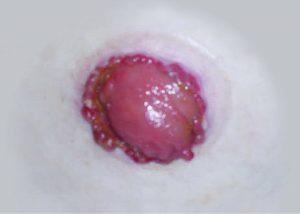
Granulomas are small, red, raised areas on or around the stoma. They develop as a result of over-healing of damaged skin on the stoma surface, possibly due to friction from the bag. Some, but not all, stoma granulomas can cause bleeding and discomfort. Also, if they are large they may prevent pouch adhesion which may result in leakage problems.
گرانولومس سٹوما کے اوپر یا اس کے آس پاس چھوٹے، سرخ، ابھرے ہوئے حصے ہوتے ہیں۔ وہ سٹوما کی سطح پر خراب جلد کے زیادہ شفا یابی کے نتیجے میں تیار ہوتے ہیں، ممکنہ طور پر بیگ سے رگڑ کی وجہ سے۔ کچھ، لیکن سبھی نہیں، سٹوما گرینولومس خون بہنے اور تکلیف کا باعث بن سکتے ہیں۔ اس کے علاوہ، اگر وہ بڑے ہیں تو وہ تیلی کو چپکنے سے روک سکتے ہیں جس کے نتیجے میں رساو کے مسائل پیدا ہوسکتے ہیں•
Stoma reversal
Improved surgical techniques mean that operations to form permanent stomas are declining. Temporary stomas allow the bowel to rest and heal.Your healthcare professional will advise whether stoma reversal is possible.
The outcome of reversal surgery depends on how much and which part of the bowel has been removed. If very little of the rectum remains, then it is likely that bowel control will be impaired.
بہتر جراحی کی تکنیک کا مطلب یہ ہے کہ مستقل اسٹوماس بنانے کے آپریشنز کم ہو رہے ہیں۔ عارضی سٹوما آنتوں کو آرام کرنے اور ٹھیک ہونے دیتے ہیں۔ آپ کا ہیلتھ کیئر پروفیشنل مشورہ دے گا کہ آیا سٹوما کو تبدیل کرنا ممکن ہے•
الٹ سرجری کا نتیجہ اس بات پر منحصر ہے کہ آنتوں کے کتنے اور کون سے حصے کو ہٹا دیا گیا ہے۔ اگر ملاشی کا بہت کم حصہ باقی رہتا ہے، تو امکان ہے کہ آنتوں کا کنٹرول خراب ہوجائے گا•
About us
AHP is a platform that EMPOWERS people living with a stoma. We’re here if you have questions, need support or just want to talk to someone who lives with a stoma.
We also run projects to empower ostomates to return to sports, hobbies and other interests and give them the confidence to take up fresh challenges. We are advocates for ostomates’ rights and their voice on the bigger issues.
Our vision
We want hidden conditions to be understood and accepted by all, so that people can reach their potential.
Our values and principles
We use these to guide everything that we do:
Support: We provide practical and emotional support and advice to people living with a stoma, their families, carers, and friends.
Empowerment: The aim of our day-to-day work is to empower people with stomas to reach their potential.
Advocacy: We act as a voice for people with stomas, raising awareness of the issues that they face to bring about positive outcomes.
Contact Us
We are here to help you, so please get in touch if you require more information, have an enquiry or would like to offer your support. Here are the various ways in which you can contact us:
Phone us
0325-9117711
Email us
contact@asfeenhealthcareproviders.org
